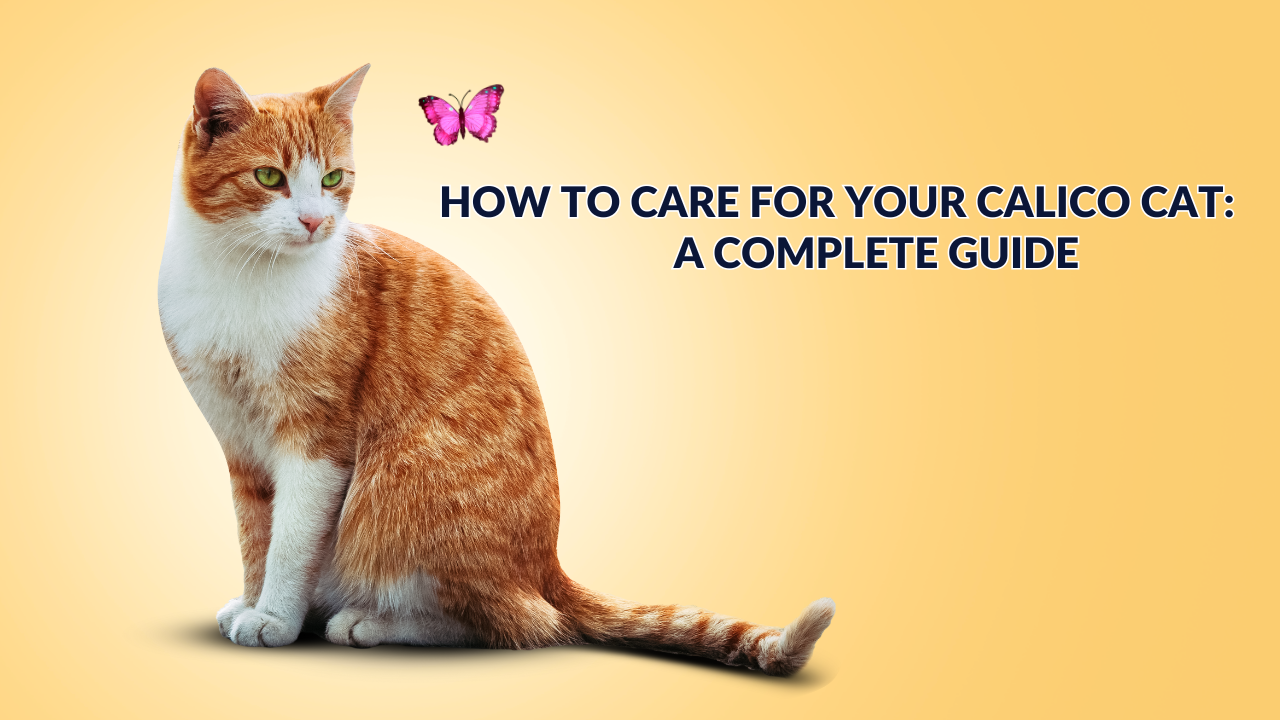Table of Contents
ToggleIntroduction
In the first section, it is necessary to explain what Calico cats refer to, their peculiarities, and why these cats should be given more regard for their care. Here, you’ll want to highlight the key reasons why Calico cats are cherished by pet owners: Based on their tri-colored coats, playful independence, and generally friendly and affectionate behavior. Introduce the blog’s main purpose:to give readers a full and detailed tutorial on how to pick and groom their calico cats professionally. Briefly, it can be mentioned that the reader will come to know about the basic facets of his or her care which is described in the article.

1. Understanding Your Calico Cat
What Makes a Calico Cat Special?
Calico cats are distinctive mainly because of their fur color. A “Calico” isn’t a breed; it’s a color pattern that includes three colors: Most commonly seen in white, black, and orange color (or even closer to them, like cream and gray). This coloration expresses the fact that the coat color gene is sex-linked and located on the X chromosome. Because a feminine feline inherits two X chromosomes, then she is likely to have this kind of pattern. Male Calicos are present in rare instances but such cats cannot reproduce due to posses genetic problems such as Klinefelter’s syndrome.
Personality Traits of Calico Cats
Calico cats are most often associated with temperamental and playful behavior. Sometimes they can be detached, even solitary, and at others, they can be very, very loving. Thus, by learning and realizing your cat’s attitude and gestures you will easily build up a better relationship with your cat. Calicos also can have “tortoiseshell traits”, on the behavioral level, it may imply it’s temperamental and the needs of the cat must be contributed to. However, Calicos are not like some set of caricatures, and every cat is a unique character but many times cats are like this only humorous and loving.
2. Creating the Ideal Home Environment
Provide Safe Spaces
This is true for calico cats and really for any cat, every cat needs to have its territory where it feels safe and at ease. This could be a corner, a comfortable box to lie on, or even a tall spot where they can view the surroundings. They provide them with a place where they can go at any one time when they feel stressed or overwhelmed by events. It is essential to pacify a cat, and since they are naturally inclined to feel they have some territory to defend, creating this space makes them feel comfortable.
Cat-Proofing Your Home
The process of turning your home into a cat-friendly house entails eliminating dangerous things within the house. These are things that they may get into and choke on, cords and plants that are poisonous to the cats like lilies and ivy among other ways you ensure your home is safe for your cat. Cats can be quite the climbers and jumpers so always be cautious around easily knockable items or precarious spaces. The windows should be well protected by their screens so that no one can escape accidentally and chemicals such as cleaners should be kept high enough so that children cannot reach them.
3. Feeding and Nutrition
Best Diet for Calico Cats
Like any other cat, Calicos require nutrition that has all the nutrients necessary for their consumption. First of all, cats are obligate carnivores so their diet should be of high quality and contain animal protein, with different types of animal sources. While wet food is rich in moisture content, dry food is appropriate for maintaining the health of the teeth of pets.
It is essential not to offer them human food or low-quality commercial cat foods as they will become overweight, develop a poor coat, or have tummy troubles. Remember always to consult your vet about what diet is more appropriate for your Calico’s age, health condition, and activity levels.
Maintaining Healthy Weight
Overweight is also observed, as a rule, in cats that spend much time indoors, and Calicos are among such cats. Cats end up being overweight without exercise most of the time leading to obesity. To decrease the risk of obesity feed your cat according to portions, do not serve NSMutable water, and ensure that it plays for several hours. They should also be fed in small portions, several times but this will help regulate their metabolic rate.
4. Grooming Your Calico Cat
Coat Maintenance
Despite being known for being a short-hair breed, Calicos will need their coat washed frequently. Comb your cat once or twice a week so that hair does not tangle and your cat sheds less. Brushing also means that dead hair will be taken out and natural oils spread out evenly resulting in a shiny and smooth coat. Cats with longer or coarser hair Reid may require more regular grooming to avoid entanglements. The same is true with Calico, which may also develop mats; you should use a detangling spray or ask for professional grooming assistance.
Nail Trimming, Ear Cleaning, and Dental Care
As is the case with all cats, Calicos need their nails clipped so that they don’t grow sharp enough to scratch furniture or even their owners. Based on the level of activity of your ‘scruff’, you need to groom the sub fabrics every 1-2 weeks. Their ears should be clean and there should be frequent cleaning for any dirt or wax and fungal infection. Should you find them dirty, wipe them with a vet-recommended ear cleaner. Dental hygiene is also equally as important when it comes to your cat as well. Daily cleaning with cat-approved toothpaste minimizes dental problems and contributes to healthy gums. If you are not sure how to brush your teeth, ask your veterinarian or look for dental treats and toys for your pet.
5. Health and Wellness
Routine Vet Visits and Vaccinations
Common Health Concerns
However, calicos are not disposed to certain diseases that are common with cats and these include diseases like kidney disease, dental disease, and of course obesity. Routine visits to the veterinarian imply the early diagnosis of disease. To increase understanding of how things are going with a pet, it is necessary to pay attention to the changes in behavior or physical states such as vomiting, drowsiness, or loss of appetite.
Maintaining an Active Lifestyle
A common problem in many breeds is playfulness and curiosity; therefore, Slabs must be engaged in activities that will help develop their bodies and their minds. Archives, Al August 2013 Toys and cat trees, and other games that can challenge the cats can allow them to exercise. Playing games or feeding a dog with a food-hiding puzzle or a treat-giving toy also helps in reducing boredom and hence eliminating destructive propensity in dogs.
6. Behavioral Tips for Calico Cats
Understanding Calico Cat Behavior
This species can be more independent than other cats are, and, thus can spend time alone sometimes. But they are also friendly and can become attached to their owner and even become loyal. It helps to be able to identify when they are seeking affection or when they are feeling too crowded.
Some Calicos may also have a touch more aggression thanks to the ‘tortoiseshell’ genes in it – a calico with a more temperamental and reactive cat. Do not get impatient with your cat i.e. do not stress your cat, and always make sure to give them their personal space.
Litter Training and General Behavior Issues
A majority of the Calicos are precocious and can be trained to litter box easily. But if your cat is having issues with littering, the box must be clean, well within reach, and placed in a quiet area free from other animals. If there is a problem and your Calico is not using the litter box, they may have stress or health issues, check with a vet.
7. Calico Cats and Socialization
Introducing Your Calico to Other Pets
Calicos can be very sensitive and may become aggressive to new pets when introduced. They should also have enough time to take each other’s temper and get familiar with each other’s smell before one touches the other. Animals should already be separated so it is recommended each should have a bed, food, and litter box of their own to avoid fights.
Bonding with Your Calico Cat
So, to build a relationship with your Calico, you have to spare some of your time and energy. Spend quiet time together as in playing or feeding gently. Understand at what times they are looking for attention, and at what times they just want to be left alone. This understanding develops a predisposition of trust and affection in that relationship.
8. Special Considerations for Senior Calico Cats
Caring for Aging Calico Cats
Your Calico, like any other animal, will likely face a decline in their activity levels and he or she might have some health problems including arthritis or dental issues. Older cats may also require bedding that is firmer and may have trouble climbing up to favorite locations, therefore ramps would be adequate. One needs to translate care to make the environment more or less senior-friendly depending on the family’s wishes.
Veterinary Care for Senior Cats
Annual check-ups with a vet become even more important when your cat is getting old. Blood tests that may need to be part of a senior person’s checkup include renal function tests, joint profile, and dental profile. Moreover, mature cats may need different changes such as diets like the weightless diet or the diet for joint cats.
Conclusion
Finally, it is necessary to present the most important pieces of advice given in the article. Remind the audience about the topic and support it using the headings concerning the Health and Grooming of Calico cats, Socialization, and Needs of Calico cats. The guidelines highlighted above will help owners see their Calico cats live long, healthy, and happy lives. This should convince readers to always consult their veterinarian for further instructions on how to take care of their pets. Finally, bring the message to the audience’s attention full circle and encourage them that there is always a kind and attentive way to accrue sexual liability.
ReadAlso:





















One thought on “How to Care for Your Calico Cat: A Complete Guide”